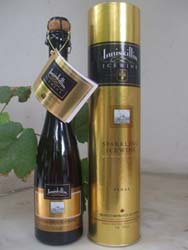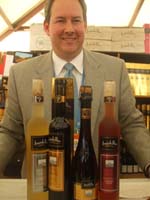The nectar that Gods drank according to Hindu Mythology, and the ‘amrit’ that came out of the ‘sagar-manthan’ must have tasted like icewine and sampling the Inniskillin Vidal sparkling icewine from Canada at Vinoble 2010 makes Subhash Arora wonder if this was not the moniker produced in that period, knowing as we do about the immense technological advancements that had been made thousands of years ago..
 What Angelo Gaja did for Barbaresco, Mondavi did for Napa wines, Torres did for Spanish and Chilean wines and Indage did for Indian sparkling wines, Donald Ziraldo of Canada certainly did for the Canadian icewine with his Inniskillin winery. No wonder, today Inniskillin are the most awarded icewines throughout the world and reportedly the most sold brand in the duty free shops throughout the world, in 69 countries. In fact, at Changi Airport in Singapore duty free shops, wines are displayed in separate racks as Australia, USA, France etc…and Inniskillin. What Angelo Gaja did for Barbaresco, Mondavi did for Napa wines, Torres did for Spanish and Chilean wines and Indage did for Indian sparkling wines, Donald Ziraldo of Canada certainly did for the Canadian icewine with his Inniskillin winery. No wonder, today Inniskillin are the most awarded icewines throughout the world and reportedly the most sold brand in the duty free shops throughout the world, in 69 countries. In fact, at Changi Airport in Singapore duty free shops, wines are displayed in separate racks as Australia, USA, France etc…and Inniskillin.
My love affair with icewine started in 2002 in Vinitaly though I had been drinking it sporadically many years earlier in the USA. I had met Don at the Show and he patiently spent an hour explaining to me the whole process and tasting the Vidal and Gold icewine (Riesling, Cabernet Franc and Sparkling Vidal were presumably added to the portfolio later).
I have been watching Don’s progress over the years and have written about him and the icewine occasionally-I must confess I am since biased towards Canadian icewine. We even organised an icewine tasting evening through Delhi Wine Club at the residence of the Canadian Commercial Counsellor in 2003 to introduce Thomas & Vaughn icewines in India. Inniskillin was bought over by Vincor which is now owned by Constellation brands; Don left the company after a few years in the advisory capacity and has recently introduced his own icewine. (Perhaps after completing the end of the non-compete clause).
But Inniskillin has moved from one award to another. One can gauge the popularity from the fact that at Vinoble, Randy Dufour, the Export Director was on his toes the whole day for 4 days, pouring for the unending stream of visitors and took a break only to attend a few seminars most of whom centering around sweet wines featured one of their Icewines –Vidal Gold, Riesling, Cabernet Franc or the recommended Vidal based sparkling wine..
Inniskillin Sparkling Icewine
The sparkling wine has undergone a second bottle fermentation and is bottled under pressure, Spumante/ Champagne style. It has a beautiful golden colour with precious tiny bubbles which are not on-your- face on pouring. In fact, they don’t impress you very much on the visuals, initially. On the nose, it has very tropical aromas. But take the first sip and you will be already flying. The bubbles not only make the already crisp wine more vivacious, they tickle and tease the palate. They persist dancing on your tongue and though the after-taste is very long, they entice you to go for the next sip sooner.
The sugar level of around 150 gms/liter, does not interfere due to the crispiness and balance of the wine. The beauty of the wine is that the sparkles are like an add on feature- even if you don’t finish the half-bottle (375 mL) at one go and the fizz is gone, you can still store it in the fridge and drink like a regular icewine for a week or so. The low alcohol level of 10% is also a welcome characteristic.
Unfortunately, it is still not available in India due to high taxation. It is not for those who feel Cava, Prosecco or the Marquise de Pompadour compare with Champagne. Even the regular Moet Chandon drinkers would find it slightly expensive. But Don Perignon lovers would get hooked to it fast-as a dessert wine or an aperitif wine with strong cheeses or with foie gras (which delWine discourages due to the inhumane process of raising the goose or duck). Many of our Indian spruced and spiced snacks would go well due to the acidity and sugar content.
Import in India
 There was a talk of Sula importing it when I had met Randy at the previous edition of Vinoble a couple of years ago. The deal did not work out-which might have been just as well since the product might not have gone well with the profile of their imported wine portfolio then. With the recent tie-up with Remy-Martini things might have been different today. Apparently, the company is now in talks with Mohan Bros. who would make good partners as they already deal in luxury wines like Moet Chandon and Don Perignon. There is an ample scope for marketing in the duty free segment. There was a talk of Sula importing it when I had met Randy at the previous edition of Vinoble a couple of years ago. The deal did not work out-which might have been just as well since the product might not have gone well with the profile of their imported wine portfolio then. With the recent tie-up with Remy-Martini things might have been different today. Apparently, the company is now in talks with Mohan Bros. who would make good partners as they already deal in luxury wines like Moet Chandon and Don Perignon. There is an ample scope for marketing in the duty free segment.
In fact, it is a wonder that Alpha Futures or any of the other duty free licensees in India have not yet decided to sell it by direct imports. The sparkling version of Vidal comes in a Golden cylinder and sells for around $80. The Vidal Gold is slightly cheaper. The wine can be stored for 4-5 years without any problem-if it lasts that long.
Subhash Arora
|